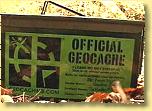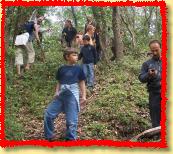
Geocaching Guidelines

The frog does not drink up the pond in which he lives. |
 Geocaching is a fast-growing outdoor recreational sport. Geocaching is the act of hiding a cache of trinkets and then announcing its geospatial position, usually on geocaching.com. Other geocachers search for your cache using their GPS tool (Global Positioning System) and, when they find it, they exchange trinkets, leave a note, and mark it in their record of located caches.
Geocaching is a fast-growing outdoor recreational sport. Geocaching is the act of hiding a cache of trinkets and then announcing its geospatial position, usually on geocaching.com. Other geocachers search for your cache using their GPS tool (Global Positioning System) and, when they find it, they exchange trinkets, leave a note, and mark it in their record of located caches.
Geocaching is a great way to explore new areas and learn GPS navigation skills. Events for large groups are organized, people make new friends, and participants get lots of exercise. It's really a fun way to mingle outdoors and technology, but it also has a high risk of causing more impact to our fragile areas - especially from novices just starting out. As with any outdoor sport that takes off fast, education of the population is crucial from the start.
Geocaching is not an appropriate sport for designated wilderness areas. In 2005, I found a geocache at about 12,000 feet in the Cloud Peak Wilderness area. This was the first cache I'd ever seen so I left it. Later, when talking to a USFS ranger, he said it would have been better to pack out the cache since it was illegal. Now I know.
 It's important to think about what you are doing before you ever start looking for a cache or consider hiding your first cache. Here are some guidelines to start with:
It's important to think about what you are doing before you ever start looking for a cache or consider hiding your first cache. Here are some guidelines to start with:
- Know how to use your GPS accurately to prevent wasted trampling while searching.
- Don't bury caches. They need to be visible when someone locates it without disrupting the area.
- Don't leave food or smellables in a cache. This will attract animals and be a stinky mess for cachers that find it.
- Use plastic containers, not glass or metal.
- Find a durable place to hide your cache. Wetlands, archaeological sites, fragile vegetation are all poor choices.
- Consider the route someone will need to take to reach your cache. Be sure existing trails can be used.
- When searching for a cache, carefully replace any natural items you move. Use all your LNT principles when geocaching.
- Be Safe. Look out for poison ivy, slippery rocks, and other dangers. Don't reach into a place you can not see - that's where biting creepy crawlies live.
- Don't trespass to place or find caches. Check with the land owner or manager before placing a cache on private or public property.
Geocaching is virtually the same as taking a hike through the woods. Staying on trails, disposing of waste, respecting wildlife and other visitors, and planning ahead are all important to remember. Keeping your group small is also important. Eight or twelve people scouring an area looking for a cache that must be around somewhere can really chew up the ground. Use some well-known caches that you've found previously to teach newbies how to geocache. Save the harder or more remote caches for very small groups that are experienced.
 As geocaching has gained in popularity, various land agencies and municipalities have created policy to deal with it while others are still figuring it out. The site at geocachingPolicy.org lists many policies.
As geocaching has gained in popularity, various land agencies and municipalities have created policy to deal with it while others are still figuring it out. The site at geocachingPolicy.org lists many policies.
In general,
- Many communities have banned caches on city property for safety, liability and aesthetic reasons.
- Other communities allow caches, but require them to be registered.
- Still other communities have banned geocaching until policies are drafted.
- National Park Service does not allow geocaching and considers caches to be abandoned property and will remove and discard them.
- Bureau of Land Management has varying policies for localities. Check with a local office about local policy.
- Forest Service generally considers caches as litter. They should be Packed Out. Individual forest offices may allow some geocaching, so check locally.
- State and public land agencies have a wide range of policy, so always check with the local authority.

